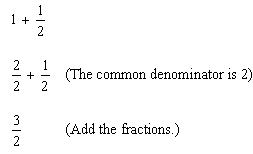A compound fraction is a fraction that has other fractions inside its numerator or denominator. Here's an example:

While compound fractions can look really hairy, they're really not that hard to simplify. There are just three steps:
1. Simplify the numerator (the top);
2. Simplify the denominator (the bottom);
3. Divide
Let me show you how these three steps are done for our example:

Step 1. Simplify the numerator.
The numerator is 1 + 1/2, and to simplify that, you just have to add:

So at the end of step 1, you've got the numerator simplified into a single fraction:

Step 2. Simplify the denominator
The denominator is 7, and that's about as simple as it can be!
Step 3: Divide.
Remember, the fraction bar is really the same thing as a division symbol. So
(3/2)/7
To divide, you just invert and multiply

And you're done! The answer is 3/14.